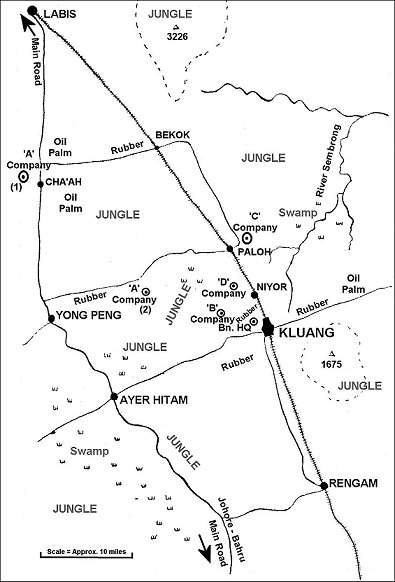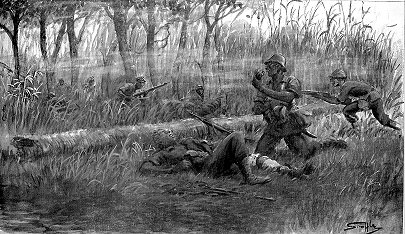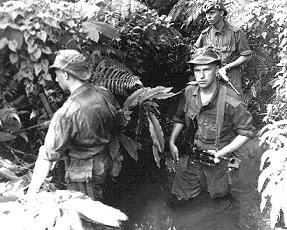Kluang itself is one of the larger towns in Johore, and its position on the railway makes it an important centre for the local rubber, oil palm, and logging industries. For most of its way through Malaya the railway follows the North-South road quite closely, but Kluang is on a part of the line which loops away from the main road, and although there are a few local roads the railway line and the estates either side of it were more than usually vulnerable. The trains were continually being shot at or derailed in the lonely jungle areas North and South of Kluang. In fact, the whole of the new Battalion area was, like Segamat, the centre of intense Communist activity.
At Kluang, Battalion Headquarters shared a camp with the 13th/18th Royal Hussars (Queen Mary’s Own), a Regiment with whom the Battalion had also shared a troopship on the way out to Malaya. Relations between the two Regiments were extremely cordial, and continued to be so for the rest of the Battalion’s tour, and a close friendship was established which, happily, is still maintained to-day.
A fairly large operation was mounted soon after the Battalion arrived in the new area. Operation Urban was carried out by “B” Company and detachments of 1st/2nd Gurkha Rifles (King Edward VII’s Own) and 22nd Special Air Service Regiment (Malayan Scouts). The Gurkhas killed four terrorists soon after the operation started and on the following day “B” Company carried out a successful ambush. 6 Platoon was in ambush on a jungle track ten miles East of Bekok. It was hoped that the Gurkas to the North would push the terrorists Southwards, and this proved to be the case. The ambush position was in close jungle with bamboo on either side of the track, and visibility was about ten yards, except on the track itself. There were five men in the position with two Bren guns. Only twenty minutes after they arrived three terrorists appeared, walking ten yards apart. When the leading terrorist had almost passed through the ambush, the Bren gunner opened fire and knocked the terrorist down; he then fired on the second terrorist. The first now tried to get up, but the Bren gunner, firing from the hip, finished him off. The other two terrorists got away although one was wounded.

Johore - Kluang
On 14th May “A” Company moved again, this time to Yong Peng Estate, twelve miles West of Kluang.
On 26th May, 12 Platoon, “D” Company (2/Lt. W. O. Morris, R.A.O.C. att. 1 Worc. R.) were encamped in some rubber on Ulu Paloh Estate, three miles West of Niyor. At about 1530 hours one of the platoon sentries was fired on by a party of eight terrorists. The sentry returned the fire and the terrorists withdrew in a North-Westerly direction. The Platoon Commander then took two sections in pursuit of the terrorists, but after making a wide circling movement through the jungle could find no trace of the enemy and returned to base.
The following morning the Platoon Commander, with two sections, set out once more in search of the enemy. They moved due West into the jungle and followed a narrow track, which had jungle on the left and felled jungle on the high ground to the right. The track was used by woodcutters who were engaged in cutting the jungle further back,
Having moved about a quarter of a mile into the jungle, the leading section came under very heavy automatic fire from the front and left flank. The patrol went to ground and returned the fire. In the first few minutes Private Dykes, the leading scout, was killed. The section commander (Corporal Stanton), two more privates (Hughes and Payne), and the Iban tracker (Awang anak Rawang), were wounded. The Platoon Commander shouted several times to Corporal Stanton to withdraw his section, but he received no reply. 2/Lt. Morris then moved back and deployed the rear section to the left; they then engaged the terrorists as best they could. 2/Lt. Morris moved forward again to investigate the state of the leading section. During this time he fired two complete magazines from his carbine. The Platoon Commander was killed shortly afterwards, but the Platoon fought on for about forty minutes, when the terrorists withdrew.
The sound of the firing had been heard back at the Company base, and the Company Commander, with two platoons, moved out and arrived at the scene of the action about an hour later.

“AMBUSH”
From the original drawing by Snaffles showing the gallant action by Awang anak Rawang
The casualties in the action were 2/Lt. W. O. Morris, Corporal B. Stanton and Private N. Dykes killed, and the wounded were Private G. Hughes, Private N. Payne and the Iban. The enemy lost three killed, including Lap Kwang, the company commander and a terrorist leader of repute. The terrorists numbered about fifty and were later identified as 3 Platoon and 7 Platoon, 4 Company, of the 9th Regiment. The two sections of 12 Platoon had a total strength of between fifteen and twenty.
July proved to be a month of success; six terrorists were killed and five were wounded.
“C” Company started with two contacts in a week. On 2nd July a section of 8 Platoon, under Sergeant Morris, was patrolling a rubber estate when five terrorists were spotted about two hundred yards away, apparently resting by a stream. Almost as soon as the patrol saw the terrorists they were themselves seen, and the terrorists started to make off. The section opened fire and the fire was returned, but the terrorists soon disappeared. The patrol followed up and found one dead terrorist. Blood trails indicated that at least two more had been wounded. The following day a pair of blood-stained trousers were found two hundred yards from the scene of the action.
Six days later, two sections of 9 Platoon were patrolling some rubber when they saw four or five terrorists on high ground ahead. The patrol opened fire and the terrorists fled. After a chase of about three hundred yards a female terrorist, who had been wounded, stopped and tried to throw a grenade, but before she could throw it she was shot dead, and the grenade exploded at her feet. The remaining enemy were chased for a further thousand yards, and a trail of blood was found, but eventually the terrorists were lost in some thick lalang. A few days later another patrol of “C” Company contacted two terrorists and wounded both of them.
Meanwhile “D” Company had added to their score. On 11th July, 10 Platoon (Serjeant Charmer) was on patrol South-East of Niyor, where terrorists had recently burned down the railway station. They were moving along the edge of a swamp, when, suddenly, the leading section went to ground. The Platoon Commander found that the leading scout had seen two civilians about sixty yards away. There was a man carrying a rifle and the other was a woman. Serjeant Charmer ordered his Bren gun forward, but the terrorists saw them moving and tried to run; the section opened fire, killing the man and wounding the woman, who managed to escape.
The biggest success of the month went to the credit of “B” Company. 4 Platoon (2/Lt. D. C. Tyson) was patrolling a very swampy area along the bank of the River Sembrong, when they found a newly-made native fish trap. As it was impossible to tell whether it had been put there by Sakai or by terrorists. A section under Corporal Nolan was left in the tall reeds to watch the river. The remainder of the platoon moved some distance back to make camp. It was not long before a sampan appeared, working its way slowly upstream. It was paddled by two Chinese and there was a Sakai woman in the stern. They must have heard some sound, as they were scanning the area of the tall reeds and keeping to the far side of the river, which at this point was about a hundred yards wide. One of the Chinese gave three low bird-like whistles; in reply Corporal Nolan challenged them to stop. The Chinese tried to paddle away, but the section opened fire and the sampan was overturned in the first volley. The two Chinese were killed and the woman mortally wounded. The Platoon had two Sakai guides who quickly made a raft and crossed the river, where they found the woman floating in some reeds. One of the guides recognised the woman and spoke to her before she died. It appeared that the two Chinese were terrorist couriers, and the Sakai woman was the wife of one of them.
Towards the end of July orders were received that the Battalion was to move yet again, this time to Klang on the coast of Selangor, due West of Kuala Lumpur. The advance party left on August 2nd.
In August the successes continued. On the morning of the 4th, 6 Platoon “B” Company (Serjeant Hall) contacted two terrorists in a swamp; Serjeant Hall killed one and the other escaped. Very shortly afterwards the Platoon Iban tracker reported large numbers of terrorists ahead, and that they were placing their hats on sticks, probably as a decoy. The enemy opened fire. The Platoon tried to work round to a flank, but in doing so ran into more of the enemy, two of whom were wounded. They then tried the other flank, at the same time using their grenade-firing rifle to drop grenades into the terrorist position. They had almost got to the rear of the position when the terrorists withdrew hurriedly. Two more of the enemy were wounded. 6 Platoon had been outnumbered by two to one. On the following day, whilst still pursuing the terrorists, two of the enemy were contacted and one killed. About a week later the companion of the terrorist, shot by Serjeant Hall, surrendered to the Police.
“B” Company was in action again before long, this time it was 5 Platoon. They observed a large number of terrorists passing some distance away. The Platoon followed up and soon discovered a large camp, only three or four days old. The Iban tacker said that there were no fresh tracks. As the Platoon began to return by their original route they came under heavy fire and the Iban was killed instantly. Then followed some difficult manoevring in extremely thick swamp, the Platoon trying to attack the enemy from the flank. After a short engagement the terrorists withdrew. It was discovered later that there had been 50 Communists in the action.
It was then the turn of 11 Platoon, “D” Company, who on August 13th ambushed three terrorists, killing one and wounding another. Two large sacks of rice, a rifle, some ammunition and a grenade were recovered.
Out at Yong Peng, “A” Company had been engaged on continuous patrolling but without a sight of the enemy, when, on August 26th, a terrorist surrendered to the Police at Yong Peng. The surrendered man led a combined Police and “A” Company patrol to a terrorist camp. The sentry fired on “A” Company who charged the camp, driving the terrorists into a Police ambush. The Police killed one and wounded one.
Three days later 3 Platoon (2/Lt. R. M. S. Fairbairn, R.A.O.C., att. 1 Worc. R.) spotted three terrorists in a jungle clearing. Whilst working their way round the position the Platoon was seen by a terrorist sitting by the jungle edge. He was killed, but the others escaped.
Although operational life at Kluang left little time for anything else, the Battalion did manage to uphold the Regiment’s reputation for shooting. After winning the 18 Infantry Brigade Rifle Meeting the Battalion was placed fourth in the Malaya Rifle Meeting. Twenty-seven major units competed. Major (Q.M.) C. E. Shrimpton won the Individual Pistol Championship.
In swimming also the Battalion scored a very convincing success in the South Malaya Swimming Meeting.
On September 2nd the Battalion (less “C” Company, who remained at Paloh) moved to Selangor. This was the fourth major move since arriving in the country, and it was a great pity that the Battalion had to leave an area which they had now got to know thoroughly, and in which recently they had had notable success. They were sorry also to say good-bye to the 13th/18th Royal Hussars, whose friendly assistance had been much appreciated. As it happened, it was not long before the two Regiments met again.

Wading through swamps at Selangor with bren gun at the ready